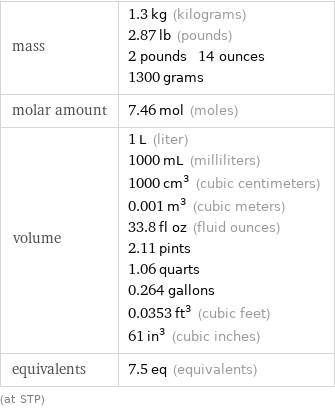Input interpretation

1 L of L-arginine
Basic properties for 1 L

mass | 1.3 kg (kilograms) 2.87 lb (pounds) 2 pounds 14 ounces 1300 grams molar amount | 7.46 mol (moles) volume | 1 L (liter) 1000 mL (milliliters) 1000 cm^3 (cubic centimeters) 0.001 m^3 (cubic meters) 33.8 fl oz (fluid ounces) 2.11 pints 1.06 quarts 0.264 gallons 0.0353 ft^3 (cubic feet) 61 in^3 (cubic inches) equivalents | 7.5 eq (equivalents) (at STP)
Corresponding quantities

sphere radius | 6.204 cm (centimeters) side of a cube | 10 cm (centimeters)
Thermodynamic properties for 1 L

latent heat of vaporization | 504 kJ (kilojoules)
Mass composition for 1 L

C (carbon) | 0.540 kg (41.4%) H (hydrogen) | 110.000 g (8.1%) N (nitrogen) | 0.420 kg (32.2%) O (oxygen) | 0.240 kg (18.4%)

Mass composition for 1 L
Lewis structure

Draw the Lewis structure of L-arginine. Start by drawing the overall structure of the molecule, ignoring potential double and triple bonds: Count the total valence electrons of the carbon (n_C, val = 4), hydrogen (n_H, val = 1), nitrogen (n_N, val = 5), and oxygen (n_O, val = 6) atoms: 6 n_C, val + 14 n_H, val + 4 n_N, val + 2 n_O, val = 70 Calculate the number of electrons needed to completely fill the valence shells for carbon (n_C, full = 8), hydrogen (n_H, full = 2), nitrogen (n_N, full = 8), and oxygen (n_O, full = 8): 6 n_C, full + 14 n_H, full + 4 n_N, full + 2 n_O, full = 124 Subtracting these two numbers shows that 124 - 70 = 54 bonding electrons are needed. Each bond has two electrons, so in addition to the 25 bonds already present in the diagram add 2 bonds. To minimize formal charge carbon wants 4 bonds, nitrogen wants 3 bonds, and oxygen wants 2 bonds. Identify the atoms that want additional bonds and the number of electrons remaining on each atom: Fill in the 2 bonds by pairing electrons between adjacent highlighted atoms: Answer: | |
Chemical names and formulas

formula | H_2NC(=NH)NH(CH_2)_3CH(NH_2)CO_2H Hill formula | C_6H_14N_4O_2 name | L-arginine IUPAC name | (2S)-2-amino-5-(diaminomethylideneamino)pentanoic acid
Substance properties

molar mass | 174.2 g/mol phase | solid (at STP) melting point | 222 °C boiling point | 368 °C density | 1.3 g/cm^3
Units
